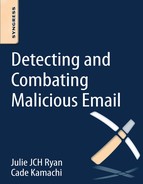Preface
This book is for ordinary users who do not have deep technical knowledge about how computers and networks operate. It is written in plain language with the goal of providing you with enough knowledge to keep yourself safe from predators while not overwhelming you with technical details. It can be read easily from beginning to end, or each chapter can be individually considered. For those who are not interested in technical details, Chapter 4 can easily be skipped. For those who are not faced with management challenges, Chapter 6 can easily be skipped.
Chapter 1 introduces the concept of malicious messaging, providing context for the more detailed information provided in later chapters. The use of messaging systems for malicious purposes is not new: examples of the misuse of the mail range back to 1838. The challenge of recognizing and not falling victim to malicious messaging is discussed, as is the cleverness of the senders, who are motivated to convince recipients of the legitimacy of the messages.
Chapter 2 provides a detailed explanation of types of malicious messaging, with actual examples. The elements of the messages that provide indicators of the malicious nature are identified. This information is very useful in understanding how to detect and not fall victim to the attack.
Chapter 3 focuses on the motivations of the senders so that reverse psychology can be used as a defense. Understanding the psychology of malicious messaging can be as much of a resource to stopping it as any technology or security analysis. This is discussed in the context of the two primary goals of the attackers and how they go about trying to achieve those goals.
Chapter 4 is the most technical of all the chapters. It describes the structure of emails and tells you how to use that structure to as an aid to determining if a received message is malicious or benign. Elements in the headers, message body, and attachments are identified and discussed.
Chapter 5 is about the detection process. The process described can be applied to any detection challenge, but is presented in the context of malicious messaging detection efforts. The use of detection experience is also described to show you how you can use your experiences to improve your detection capabilities.
Chapter 6 is for those readers who are faced with the challenge of addressing the problem of malicious messaging for more than simply themselves. A framework for creating both defense in depth and defense in breadth for an enterprise is described. The framework addresses both the people and the technologies that can be used in these defenses.
Chapter 7 contains some final thoughts and recommendations. Since knowing what to do in case you fall victim is as important as knowing how to avoid danger in the first place, these thoughts can guide you through reaction and recovery.
For educators, this book can serve as a starting point for building awareness about dangers that lurk in electronic messaging. For managers, it can serve as a cornerstone to training programs designed to enhance corporate security and establishing safe computing behavior patterns. For parents, it can be of assistance in talking to children about the challenges associated with engaging in online communications.
..................Content has been hidden....................
You can't read the all page of ebook, please click here login for view all page.
